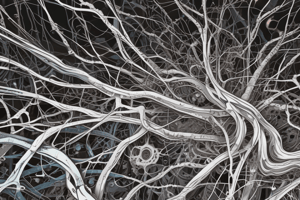Podcast
Questions and Answers
What is the primary function of the perforant pathway in the hippocampal circuitry?
What is the primary function of the perforant pathway in the hippocampal circuitry?
- To modulate synaptic strength in CA1
- To transfer sensory and associative information to the hippocampus (correct)
- To facilitate long-term potentiation
- To enhance memory retrieval
What is the significance of low extracellular calcium concentrations in synaptic transmission?
What is the significance of low extracellular calcium concentrations in synaptic transmission?
- They completely inhibit synaptic potentiation.
- They allow augmentation to still potentiate postsynaptic responses. (correct)
- They enhance the speed of action potential generation.
- They decrease the duration of synaptic responses.
What type of cells do mossy fibers from the dentate gyrus synapse onto?
What type of cells do mossy fibers from the dentate gyrus synapse onto?
- Granule cells in the dentate gyrus
- Pyramidal cells in the cortex
- Pyramidal cells in the CA1 region
- Pyramidal cells in the CA3 region (correct)
What characterizes post-tetanic potentiation (PTP)?
What characterizes post-tetanic potentiation (PTP)?
What initiates long-term potentiation (LTP) in neuron circuits?
What initiates long-term potentiation (LTP) in neuron circuits?
Which receptor's activation is crucial for the induction of long-term potentiation?
Which receptor's activation is crucial for the induction of long-term potentiation?
Which protein is essential for maintaining vesicle availability during synaptic potentiation?
Which protein is essential for maintaining vesicle availability during synaptic potentiation?
What is the effect of high-frequency action potentials on postsynaptic membrane potential?
What is the effect of high-frequency action potentials on postsynaptic membrane potential?
What happens to the magnesium (Mg²⁺) block during LTP induction?
What happens to the magnesium (Mg²⁺) block during LTP induction?
During which condition is maximum action potential generation achieved in spinal motor neurons?
During which condition is maximum action potential generation achieved in spinal motor neurons?
Which signaling molecule is activated following calcium influx during LTP?
Which signaling molecule is activated following calcium influx during LTP?
How does potentiation enhance neurotransmitter release in comparison to augmentation?
How does potentiation enhance neurotransmitter release in comparison to augmentation?
The insertion and activity of which receptors are increased due to phosphorylation during LTP?
The insertion and activity of which receptors are increased due to phosphorylation during LTP?
What is the timeframe of synaptic response enhancement due to prolonged stimulation?
What is the timeframe of synaptic response enhancement due to prolonged stimulation?
How long can the potentiation resulting from long-term potentiation last?
How long can the potentiation resulting from long-term potentiation last?
What role does the pattern of presynaptic stimulation play in synaptic transmission?
What role does the pattern of presynaptic stimulation play in synaptic transmission?
What characterizes long-term potentiation (LTP)?
What characterizes long-term potentiation (LTP)?
What role does PKA play in the long-term maintenance of LTP?
What role does PKA play in the long-term maintenance of LTP?
Which statement about the persistence of LTP is accurate?
Which statement about the persistence of LTP is accurate?
What is a key difference between Early Phase LTP (E-LTP) and Late Phase LTP (L-LTP)?
What is a key difference between Early Phase LTP (E-LTP) and Late Phase LTP (L-LTP)?
Which of the following is an expected property of a physiological basis for memory?
Which of the following is an expected property of a physiological basis for memory?
Which protocol is known for reliably inducing LTP in a neural circuit?
Which protocol is known for reliably inducing LTP in a neural circuit?
What initiates the process of LTP at the synaptic junction?
What initiates the process of LTP at the synaptic junction?
Which physiological pattern of stimulation is known to induce LTP?
Which physiological pattern of stimulation is known to induce LTP?
What happens immediately following the application of tetanic stimulation?
What happens immediately following the application of tetanic stimulation?
What effect does weak high-frequency stimulation have on synaptic strength?
What effect does weak high-frequency stimulation have on synaptic strength?
What is a key aspect of early-phase LTP?
What is a key aspect of early-phase LTP?
What occurs when the depolarization of the postsynaptic membrane is sufficient during LTP induction?
What occurs when the depolarization of the postsynaptic membrane is sufficient during LTP induction?
Which factor is crucial for sustaining the postsynaptic response after initial potentiation during LTP?
Which factor is crucial for sustaining the postsynaptic response after initial potentiation during LTP?
Which structure is primarily targeted during tetanic stimulation in the hippocampal region?
Which structure is primarily targeted during tetanic stimulation in the hippocampal region?
What is NOT a feature of long-term potentiation?
What is NOT a feature of long-term potentiation?
Which transcription factor is activated by PKA to promote gene expression during L-LTP?
Which transcription factor is activated by PKA to promote gene expression during L-LTP?
What is the primary effect of Long-Term Depression (LTD) on synaptic connections?
What is the primary effect of Long-Term Depression (LTD) on synaptic connections?
What triggers the induction of LTD?
What triggers the induction of LTD?
Which of the following is a molecular mechanism involved in LTD?
Which of the following is a molecular mechanism involved in LTD?
How does LTD affect AMPA receptors at the postsynaptic membrane?
How does LTD affect AMPA receptors at the postsynaptic membrane?
Which type of calcium signal is associated with LTD compared to LTP?
Which type of calcium signal is associated with LTD compared to LTP?
What role does calcineurin play in the early phase of LTD?
What role does calcineurin play in the early phase of LTD?
What is a key molecular player in both Long-Term Potentiation (LTP) and LTD?
What is a key molecular player in both Long-Term Potentiation (LTP) and LTD?
Which statement best describes the diversity of LTD compared to LTP?
Which statement best describes the diversity of LTD compared to LTP?
Study Notes
Synaptic Potentiation
- Augmentation: An increase in strength of the postsynaptic response, lasting several seconds, which can occur even under low calcium conditions.
- SNARE Proteins: Augmentation suggests enhanced activity of SNARE proteins involved in vesicle fusion.
- Prolonged Enhancement: Synaptic response can persist beyond stimulation, especially after intense high-frequency stimulation (tetanic stimulation).
- Tetanic Stimulation: Intense stimulation that triggers maximal action potential firing in neurons.
- Post-Tetanic Potentiation (PTP): Potentiation lasting minutes after tetanic stimulation.
- Synapsin Dependence: Potentiation requires synapsin proteins, which help mobilize vesicles from a reserve pool to a releasable pool.
Dynamic Regulation of Synaptic Transmission
- Interactions of Short-Term Plasticity: Short-term plasticity mechanisms work together to modulate synaptic transmission during repetitive activity.
- Presynaptic Stimulation Pattern: Pattern of high-frequency action potentials followed by a single action potential after 30 seconds.
- Postsynaptic Membrane Potential: Initial sharp rise, peak, decline, and then a second increase in response to the single action potential after 30 seconds.
The Hippocampal Circuitry and Synaptic Plasticity
- Hippocampus: Crucial for memory formation, studied extensively in rodents and humans.
- Perforant Pathway: Sensory and associative information from the cortex enters the hippocampus via this pathway.
- Dentate Gyrus: Granule cells in the dentate gyrus receive input from the perforant pathway.
- Mossy Fibers: Axons from granule cells, projecting to the CA3 region of the hippocampus.
- CA3 Region: Pyramidal cells in the CA3 region receive input from mossy fibers.
- Schaffer Collaterals: Axons of CA3 pyramidal cells, projecting to and synapsing onto CA1 pyramidal cells.
Long-Term Potentiation (LTP)
- Definition: Long-lasting enhancement of signal transmission between neurons resulting from their synchronous stimulation.
- Mechanism:
- High-Frequency Stimulation: Induces LTP by causing sustained depolarization of the postsynaptic neuron.
- NMDA Receptor Activation: Depolarization removes the magnesium block from NMDA receptors, allowing calcium influx.
- Calcium Signaling: Calcium influx activates CaMKII and PKC, phosphorylating proteins.
- AMPA Receptor Trafficking: Phosphorylation increases AMPA receptor activity and insertion into the postsynaptic membrane.
- Gene Expression and Protein Synthesis: Involved in long-term LTP maintenance, leading to structural changes.
- PKA and CREB: PKA activated by repeated stimulation translocates to the nucleus, activating CREB, which promotes gene expression for synaptic growth and stability.
Various Protocols for Inducing LTP
- Tetanic Stimulation: High-frequency burst of stimuli (around 100 Hz) delivered to the presynaptic neuron, often targeting Schaffer collateral fibers in the hippocampus.
- Early Phase LTP (E-LTP): Does not require new protein synthesis, primarily mediated by phosphorylation of existing proteins and changes in postsynaptic receptors.
- Late Phase LTP (L-LTP): Requires gene transcription and new protein synthesis, associated with long-lasting structural changes like new synapse formation.
- High-Frequency Stimulation (HFS): Square pulse of maximal action potential production.
- Theta-Burst Stimulation (TBS): Produces the same response as HFS.
- Pairing Protocol: Both components are active together.
Factors Influencing LTP
- Frequency of Stimulus:
- Weak High-Frequency Stimulation: Leads to transient potentiation, a temporary increase in synaptic strength.
LTP and Hebb's Postulate
- "Cells that fire together, wire together"
- Coincidence Detection, Associativity, and Specificity: Fundamental mechanisms for learning and memory.
Properties of LTP
- Rapid Induction: LTP can be induced rapidly, allowing for quick synaptic changes in response to new information.
- Graded: LTP strength is modulated by stimulation frequency and intensity.
- Associative: Integration of simultaneous inputs supports complex associative learning.
- Persistent: LTP can last for months or years, providing a durable basis for long-term memory.
- Synapse-Specific: LTP occurs only at stimulated synapses, preserving circuit specificity.
- Induced by Physiological Stimuli: Natural hippocampal rhythms like theta-burst stimulation can induce LTP.
Molecular Mechanism of Early-Phase LTP (E-LTP)
- NMDA Receptor and AMPA Receptor Interaction: Crucial for LTP induction and maintenance.
- Glutamate Release: Released from the presynaptic neuron.
- Activation of AMPA Receptors: Glutamate binds to AMPA receptors, allowing sodium influx and postsynaptic membrane depolarization.
- Depolarization and NMDA Receptor Activation: Sufficient depolarization removes the magnesium block from NMDA receptors.
- Calcium Influx and Signal Amplification: Calcium influx activates CaMKII and PKC, which phosphorylate proteins.
- AMPA Receptor Insertion and Activity: Increased AMPA receptor activity and insertion into the postsynaptic membrane.
- Local Translation: mRNAs can be translated locally at the synapse for rapid responses to synaptic activity.
Long-Term Depression (LTD)
- Definition: Weakening of synaptic connections induced by persistent low-frequency activity.
- Mechanism:
- Low-Frequency Stimulation: Induces LTD.
- NMDA Receptor Activation: Similar to LTP, but weaker calcium signal activates different pathways.
- Protein Phosphatases: Calcium activates protein phosphatases, like calcineurin and PP1, which dephosphorylate proteins.
- AMPA Receptor Internalization: Dephosphorylation leads to AMPA receptor removal from the postsynaptic membrane, weakening the synapse.
- Long-Term Changes: LTD involves gene expression and protein synthesis for synaptic pruning and reduction of dendritic spines.
LTP vs. LTD
- Type of Stimulation: LTP is induced by high-frequency stimulation, while LTD is induced by low-frequency stimulation.
- Calcium Dynamics: LTP is triggered by rapid and intense calcium increases, while LTD is triggered by slow and moderate calcium increases.
- Key Molecular Players: Both involve AMPA and NMDA receptors.
- Diversity of LTD: LTD exhibits greater diversity in molecular mechanisms compared to LTP, with different pathways and molecules depending on the circuit.
Phases of LTD
- Early Phase LTD: Involves activation of calcineurin, which dephosphorylates substrates leading to AMPA receptor internalization, decreasing synaptic strength.
Studying That Suits You
Use AI to generate personalized quizzes and flashcards to suit your learning preferences.
Related Documents
Description
Explore the mechanisms of synaptic potentiation and the dynamic regulation of synaptic transmission in this quiz. Topics include augmentation, SNARE proteins, tetanic stimulation, and the role of synapsin proteins. Test your understanding of how these concepts relate to synaptic activity and short-term plasticity.



